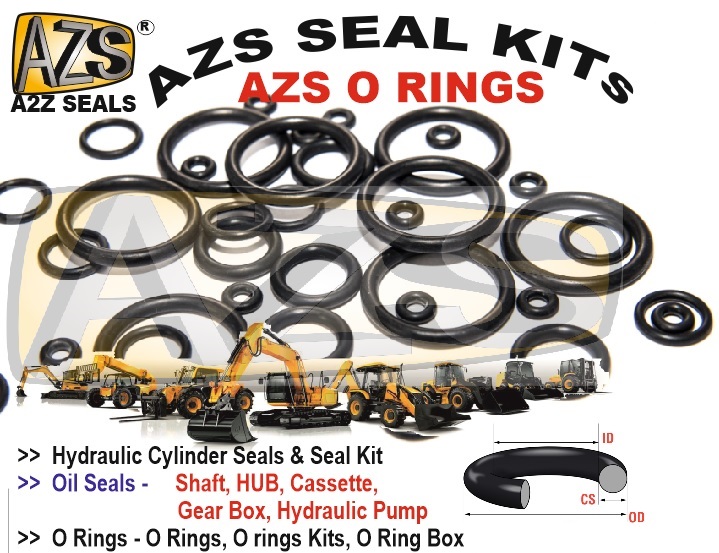Fluorocarbon elastomers a high class performance elastomers combination of excellent c-c bond with fluorine(35–75 wt%), thermal, oxidative and fluid resistance with very good tensile and compression-set resistance properties.
Fluorocarbon elastomers : are classified into three categories:
- 1. Random copolymers of vinylidene fluoride with perfluorooelfins such as hexafluoropropylene, tetrafluoroethylene, and perfluoroalkyl vinyl ethers. Cure site monomers may also be incorporated.
- 2. Copolymers of tetrafluoroethylene and propylene (in about equal molar amounts) which have mostly an alternating structure. Cure site monomers may also be incorporated.
- 3. Copolymers of tetrafluoroethylene with perfluoroalkyl vinyl ethers. Cure sites are imperative for curing these highly inert materials.
Curing chemistry suitable for each composition has been developed. The polymer structure is very important in determining the physical properties of an elastomer. However, the crosslinking chemistry used in curing determines to a great extent the properties of the final rubber part.
About FKM Fluorocarbon
Fluorocarbon elastomers have grown to major importance in the sealing industry. Due to its wide range of chemical compatibility, temperature range, low compression set, and excellent aging characteristics, fluorocarbon rubber is the most significant single elastomer developed in recent history. Fluorocarbon elastomers are highly fluorinated carbon-based polymers used in applications to resist harsh chemical and ozone attack.
The working temperature range is considered to be -26°C to +205°/230°C (-15°F to +400°/440°F).
For short working periods it will take even higher temperatures.
Special compounds having improved chemical resistance are also available with new types always being developed in our own R&D centers.
Generally speaking, with increasing fluorine content, resistance to chemical attack is improved while low temperature characteristics are diminished. There are, however, specialty grade fluorocarbons that can provide high fluorine content with low temperature properties.
FKM applications
Fluorocarbon O-rings should be considered for use in aircraft, automobile and other mechanical devices requiring maximum resistance to elevated temperatures and to many fluids. FKM (FPM, Viton®, Fluorel®) resist mineral oils and greases, aliphatic, aromatic and also special chlorinated hydrocarbons, petrol, diesel fuels, silicone oils and greases. It is suitable for high vacuum applications. Many fluorocarbon compounds have a higher than normal mold shrinkage rate, molds for fluorocarbon products are often different from molds for Nitrile.
VITON / FKM vs NITRILE: WHICH MATERIAL?
FLUOROCARBON (VITON®/ FKM) VS NITRILE (NBR): WHICH MATERIAL IS RIGHT FOR YOUR APPLICATION?
AZS O-rings can be used in many applications as they are manufactured from a wide range of materials. AZS O-rings are usually made from rubber, or more specifically, polymers / elastomers. These polymers are usually cured by vulcanisation which results in strong, durable and more elastic rubber materials.
Because of the wide range of materials available, it can be difficult to determine which is the most suitable for a project. It’s important to remember that different materials have different properties; For example, some are more elastic and others are more tear resistant in addition to other key qualities.
Viton® / FKM and NBR are two of the most commonly used elastomers for sealing applications, and for good reason. Both of these materials are suitable for general purpose applications. They offer excellent compression set resistance, and both are designed to resist most oils and lubricants, especially petroleum-based lubricants. Additionally, moderate temperature applications between -15°C and 100°C are served by both compounds, making either material a very good choice for general industrial use.
However, for more specific applications, the decision on material becomes much more important. Viton®/ FKM and NBR compounds have several very crucial differences that make them well-suited to certain applications. While both AZS Viton/ FKM and NBR seals act as very good sealing options at moderate temperatures, AZS Viton®/ FKM is far superior for high temperature applications.
STANDARD VITON® / FKM VS STANDARD NITRILE
- Our Standard Viton®/FKM compounds can provide continuous sealing at temperatures up to approximately +205°C.
- Standard NBR on the other hand is only effective for continuous sealing at temperatures up to +100°C (with short term sealing at 120°C.)
- At temperatures below -15°C, standard Viton/FKM seals are less effective as they become quite hard and inflexible. Special Viton® / FKM compounds can provide low temperature capabilities of -20°C.
- Standard NBR will operate successfully at -25°C (However, some special NBR compounds can provide effective sealing down to temperatures of -35°C,)
In addition to temperature, other application conditions differentiate these two compounds. Viton® /FKM has a wide chemical resistance range, which makes it ideal for most applications involving oils, fuels, and mineral acids. Viton®/FKM also offers excellent resistance to oxidation, ozone, UV exposure, weather, fungus and mould. Although NBR also supports some of the same chemical resistances, it is much less universally resistant than its Viton®/FKM counterpart, suffering degradation from weather and ozone exposure. For most circumstances, however, this may not be an issue. NBR also offers the benefit of superior abrasion and tear resistance making them better suited for more heavy duty industrial applications.
MATERIAL SUMMARy
NBR :
NITRILE (NBR) Nitrile rubber, Buna-N,
FKM :
FLUOROCARBON (VITON®/FKM)
Temperature range:
NBR :
-35°C and +100°C (+120°C intermittent)
FKM :
-25°C to +205°C (+230°C intermittent)
Suited for:
NBR :
General purpose sealing, such as petroleum oils, water and some hydraulic fluids. NBR is also resistant against tears and abrasive treatment.
FKM :
Fluorocarbon Viton®/FKM is an all-round material that is suitable for a number of applications, especially diverse sealing applications involving movement. It is also suited for petroleum oils, silicone fluids and gases, acids and some halogenated hydrocarbons, like carbon tetrachloride.
Deficiencies:
NBR :
Nitrile/NBR can have issues with automotive brake fluid, ketones, phosphate ester hydraulic fluids, and nitro and halogenated hydrocarbons. While it is ozone and weather resistant, this resistance is not infallible but can be supported through compounding.
FKM :
Fluorocarbon Viton®/FKM is not recommended for Skydrol, amines, esters and ethers with low molecular weight and hot hydrofluoric acids.
Applications
NBR :
Nitrile functions well in applications that have limited temperature and resistance requirements.
FKM :
Viton®/FKM AZS O-rings are very versatile, and feature in many different automotive, appliance and chemical processing industries.
Both of these elastomers are suited for an extensive list of diverse applications, and they serve as excellent general purpose seals. Nevertheless, to optimise your choice in seals it is essential to consider the advantages and disadvantages of both materials.For more information, expert consultation or a quote on NITRILE (NBR) Nitrile rubber, Buna-N, Viton® / FKM or Nitrile seals, please contact our technical Sales team. Call +91 98310 98320 or email a2zseals@gmail.com

